It only took us 200,000 years.
In the 200,000 years of homo sapiens, we poked around down here a bit and then marched off our blue-quilted rock to greet the stars. For all our faults, making it to space in a fraction our planet’s lifespan is pretty, pretty good.
Of course, we can’t all be a Galileo or an Armstrong. Behind every “small step for man” are thousands of men and women working in laboratories, classrooms and control centers. We partnered with Christopher Nolan’s #Interstellar, in theaters & IMAX November 7th, to salute the lesser-known engineers, scientists and dreamers that changed the space game -- not to mention all of human history. If it only took 200,000 years for human ingenuity to get us this far, who knows? Our greatest accomplishments in space may come sooner than we think.
John Wilkins
John Wilkins probably would've hosted Cosmos, had it aired in 17th Century England
If you thought the space race began around the time we had airplanes or, you know, steam engines, we couldn't fault you. Even we were surprised by John Wilkins, the space pioneer of Jacobean England.
Born in 1614, the Oxford-educated Wilkins lived through a tumultuous time during which ancient science succumbed to new theories at an unsettling pace. Wilkins embraced the expanded universe posited by Copernicus and Galileo and, in a series of books, wrote about it in language accessible to the layman. Wilkins was spokesman, educator and defender of physics -- imagine a bewigged British version of Neil Degrasse Tyson.

Wilkins may be our galaxy's finest writer of book titles
But he did something bigger: he dreamed up what may have been the first spaceship.
In a A Discourse Concerning a New Planet, published in 1640, Wilkins explained how “sky travelers” might escape the pull of gravity and survive in cold, empty space. He even described a “sky chariot” to get travelers to the moon -- in a journey he estimated to take 180 days. It was the first scientific treatment of the subject. One of his students, natural philosopher Robert Hooke, suggested in his diary that he and Wilkins built a model on the Oxford campus. But the age's primitive technology kept them grounded.
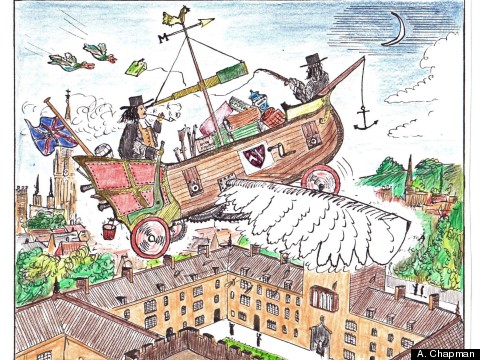
Wilkins' biographer, Professor Allan Chapman, made this AMAZING drawing based on the Englishman's descriptions of the "sky chariot"
It’d be another few centuries before innovators picked up the thread again and spun it into something real.
Konstantin Tsiolkovsky
The father of rocket science
Caution: this might make you feel bad about the one measly book you read per month. Because Russian innovator Konstantin Tsiolkovsky basically invented rocket science -- without much besides a public library card.
Tsiolkovsky, the fifth of eighteen children, was born to a family of foresters in a central Russian village. (Google Street View hasn’t gotten around to it yet.) A bout with scarlet fever at age ten left him deaf, withdrawn and -- eventually -- suspended from school. Tsiolkovsky’s father sent the book-obsessed youth to Moscow, where he fed his mind at public libraries. With scraps for an allowance, he fed his body stale bread.
But he didn’t limit his reading to physics and chemistry. Tsiolkovsky found inspiration while pouring over the science fiction of Jules Verne. He also found problems. In an early example of uber-nerdiness, he calculated that the acceleration of the cannon Verne used to launch his characters into space would have the unfortunate effect of, you know, killing them.
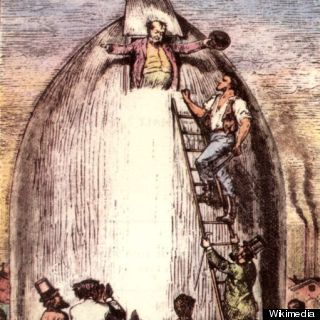
"Worst spaceship ever": Tsiolkovsky critiqued the space cannon from Vernes' From the Earth to the Moon
Flirtations with a career in science fiction turned to an astounding period of science discovery. In 1903, Tsiolkovsky published the Exploration of the World Space with Reaction Machines in a relatively obscure magazine. The article -- no big deal -- formulated an equation that mapped a rocket’s dwindling mass, the velocity of its escaping gasses, and its final speed. It was the foundation of rocket science. He also proposed liquid rocket fuel of composition uncannily similar to that used for space shuttle launches. He imagined the workings of airlocks. And, finally -- as if he needed more -- Tsiolkovsky in 1923 proposed multi-stage rockets.
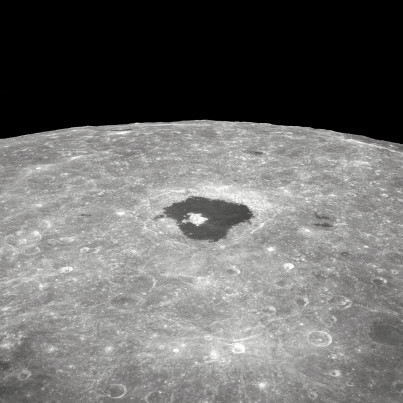
Tsiolkovsky did manage to get a crater named after him -- but on the far side of the moon
For all this, he's considered the inventor of modern rocketry.
Robert Hutchins Goddard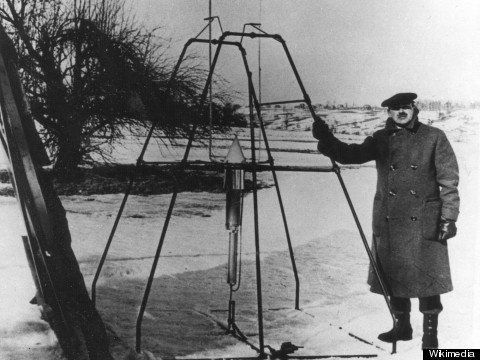
In the extended family of space innovators, Tsiolkovsky is the wise grandfather that always buys books for your birthday. Goddard, on the other hand, is the grandfather who builds stuff in his garage and lets you watch as he blows it up.
Although a gifted theoretician that discovered many of Tsiolkovsky's formulas independently, he's best remembered as an inventor, engineer and tinkerer. (It speaks to the breadth of his achievements that his official NASA biographers settled for lots and lots of bullet points.)
In 1920, however, he was a national laughingstock.
It must have been painful for a man who had struggled so long to capture anyone's attention. Goddard grew up a sickly, studious youth in early 1900s Maryland; he traded an early obsession with H.G. Wells for an obsession with making things fly really fast. His early work improving rocket efficiency convinced few. Despite inventing the bazooka (!) in the waning days of World War I, he failed to entirely convince the US military of his inventions' utility. Finally, after five years of funding his own experiments, the Smithsonian picked up the tab.
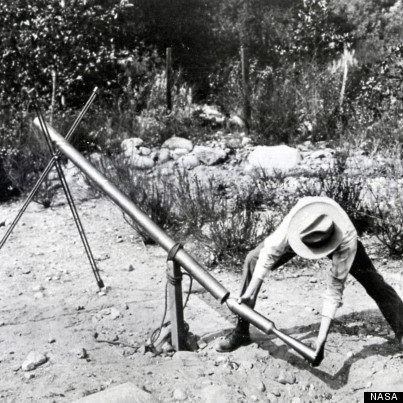
The bazooka? Goddard invented it in 1918 as a SIDE PROJECT
Unfortunately, the Smithsonian's money brought the wrong kind of scrutiny. The press picked up on a Goddard proposal -- that sending a rocket to the moon was entirely possible -- and blasted him for it. Ultimately, the New York Times issued a retraction for their scathing attack –- after Apollo 11 reached the moon.
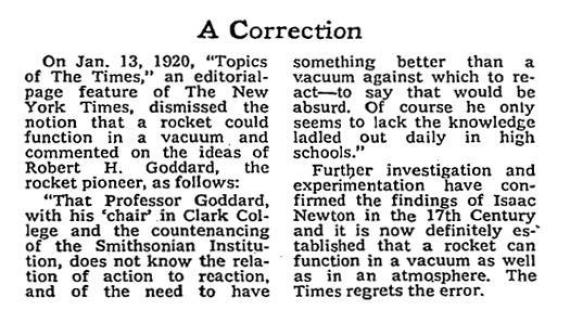
In 1969, the New York Times finally made it right by Goddard
The wounded Goddard burned on but without the recognition he deserved. In 1926, in his greatest achievement, he launched the first liquid-fueled rocket, which flew 41 feet in 2.5 seconds. It beat the similar, albeit more advanced German V2 into existence by almost two decades. Had he lived past 1945, one imagines he would've felt vindicated: his fuel-delivery designs were fundamental to modern rocketry.
Sergei Korolev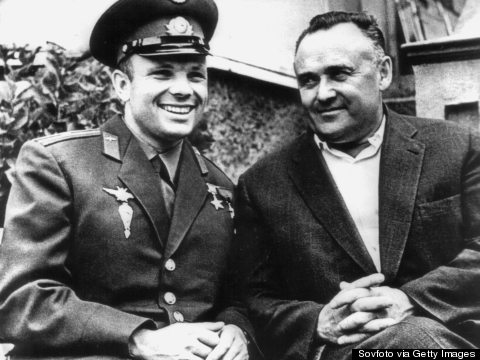
Soviet space czar Sergei Korolev, right, celebrates another victory with Yuri Gagarin, the first human in space
Had the space race gone to some cosmic judge's scorecards in 1961, the result wouldn't have been pretty. The U.S.S.R. had trounced the U.S. in every way. And they did it almost entirely thanks to Sergei Korolev -– a bear of a man possessing the rarest combination of theoretical vision, practical know-how, political savvy and administrative skills. (Only Wernher von Braun, the Nazi nabbed by the U.S. to run their space program, came close.)
It's a miracle that the Soviet Union didn't kill him first.
After a promising start in aeronautics in Ukraine and the U.S.S.R., Korolev landed on the wrong side of a Stalinist purge in 1938. His crime is disputed and seemingly petty, but the state alleged treason. He ended in the most notorious of gulags –- the Kolyma goldmine in Siberia. The brutal treatment he received during his 7-year incarceration shattered his health, leaving him toothless and unable to fully move his neck and jaw.

Gulag prisoners ponder their fate near the deadly mines of Kolyma
Fortunately for Korolev, it dawned upon Stalin that scientists might come in handy when battling Nazis. With the help of a mentor (also jailed), Korolev clawed his way to a prisoner work program, then to the military, then to the position of “Chief Designer.” (Though he allegedly still received threats from secret police.)
From there, he designed, managed and engineered an unprecedented string of Soviet space victories. In 1951, he launched the first ICBM. In 1957, he followed with the Sputnik satellite, the first manmade object in space. Then, in 1959, the unfortunate Laika the Dog roasted while becoming the first living thing in orbit. Finally, after the first lunar probe in 1960, the coup de grace: Korolev sent the affable Yuri Gagarin into orbit on the back of his Vostok 1 rocket. All this despite cash constraints and the heft of Soviet bureaucracy, which required, according to scholars, his team to donate their wristwatches for parts.
Alas, poor Korolev never quite escaped being the kicked puppy-naut of the Soviet Space Program. Even during the 1961 fete in the Red Square -– a celebration for the manned spaceflight that he orchestrated –-Korolev's car broke down and left him stranded on the side of the road. Until 1966, when a botched surgery killed him, the Soviet Union never publicized or even mentioned his contributions to their space program.

The Korolev Cross: the beautiful, symmetrical pattern by which boosters drop from Korolev's R7 Rocket
Dr. W.R. “Randy” Lovelace II and the Mercury 13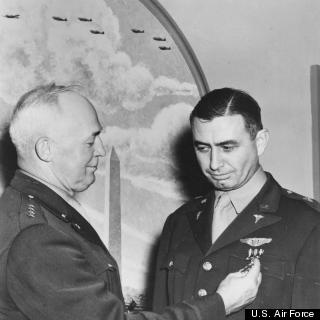
Then-Lieutenant Colonel Lovelace receives the Distinguished Flying Cross in 1943
No gulags or gold mines marred the early life of pioneering space biologist Dr. Randy Lovelace. The good doctor studied at Harvard, practiced at the prestigious Mayo Clinic and joined the Air Force, where he developed -- and personally tested, at 40,000 feet -- a high-altitude oxygen mask that protected pilots against the disorienting and deadly effects of hypoxia.
No one quite knew what effect space travel would have on the human body. So, in 1958, NASA pegged Lovelace to build the physical and psychological test regime for selecting the country’s first astronauts, the men known as Mercury 7. (The battery of ‘oscopies that they underwent is still ... uncomfortable to read.)
If that were all Lovelace accomplished, we’d still put him on the list. But instead he went ahead and tried to send women into space -- in 1960, when only 25 percent of women had a job outside of the home.
The benefits of the female astronaut were, to Lovelace, obvious. Women’s smaller bodies fit better in tiny space capsules. They ate and breathed less. That meant less fuel to launch. (Even for men, Project Mercury had a strict height and weight limit.) Plus, women had fewer heart attacks and were thought to do better in isolation.
So, after NASA and the Air Force scrapped a fledging program for female astronauts, Lovelace stepped in. With his own clinic's funds, he started the Women in Space Program. Starting with ace Jerrie Cobb, a select group of female pilots were invited to take the same grueling tests given by the same staff that the Mercury 7 received.
Thirteen women passed. It was a higher completion percentage than the group of men. Moreover, they set records, hitting marks the scientists thought impossible in isolation studies.
The elite group was dubbed the Mercury 13.

Ace pilot Jerrie Cobb had the "right stuff"
But they never made it to space. NASA demanded an end to the program -- even as the Soviet Union sent a woman to space in 1963. Lovelace died in a place crash in 1966. And the pioneering pilots of Mercury 13 were forced to wait decades until Sally Ride and Eileen Collins took up their mantle.
The Seamstresses of Playtex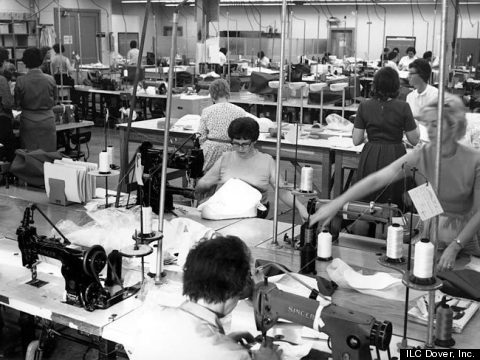
Playtex offered some serious support for the Apollo mission
How’s this for a segue: from Lovelace we shuttle over to the maker of lacy undergarments. Because it was International Latex Company, better known for its consumer brand Playtex, that constructed the A7L -- the first spacesuit worn on the moon.
Yes. This company made the Apollo spacesuit.
The epic, heartwarming tale of bra-maker versus military-industrial complex started in 1962, when a Playtex creation won a NASA contract to design the Apollo spacesuit. The NASA of the era -- perhaps uncomfortable granting such responsibility to the untrusted crafters of icky girl stuff -- relegated Playtex to subcontractor status under aerospace giant Hamilton Standard. The relationship between Hamilton and Playtex quickly came unhooked. Hamilton submitted its own prototype suit to NASA. When that failed, Playtex got the blame, and a pink slip.

Other suits allowed all the movement of a sea cucumber
But our intrepid brassiere heroes persevered. Under the guidance of a chief engineer who got his start as the CEO’s TV repairman, the Playtex crew broke into a Hamilton office to steal back their original design. Their team of seamstresses worked 24-hour shifts to get their suit into shape for a three-way competition in 1965. The other entries favored a rigid, industrial design that made movement slightly, well, impossible. (Indeed, one competing entry couldn’t fit through the door of the capsule. The other entry's helmet blew up.)
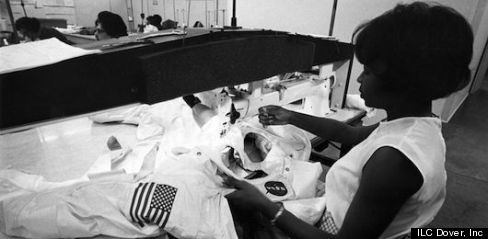
The seamstresses worked around the clock to deliver an updated design for Armstrong & company
Playtex triumphed, and their spacesuit was a triumph of craftsmanship. Their suit pulled parts from their line of underthings into a completely new and innovative combination. Their seamstresses, pulled directly from bra and girdle manufacturing lines, hand-sewed 21 layers of different materials in each suit to “a 64th of an inch tolerance.” (In other words, close.) No pins were allowed.
It was, in fact, the world’s most fitted spaceship.
Dr. Nancy Grace Roman
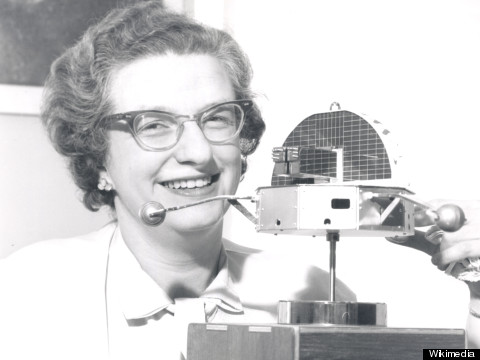
The starbound Nancy Grace Roman
So many space innovators ended their lives unfulfilled. They saw their ideas belittled; they witnessed technology’s failure to keep pace with the dream-fueled engines of their imagination. But not Nancy Roman. The extraordinary astronomer, known affectionately as the Mother of the Hubble, made it to the stars.
Nancy Grace Roman says she always knew she’d be an astronomer. As the daughter of a geophysicist who always encouraged her study of science, the stars were always in her life. At age 4, her favorite thing to draw was the moon. At age 11, she founded a school astronomy group. And despite the formidable barriers to women at the time, NASA approached Roman in 1959, a year after their formation, and offered her a job developing orbital astronomy platforms. (Part of it may have been jealousy: the Russians had taken note of an academic paper Roman wrote and invited her to an observatory opening.)
Of course, the vision of an orbiting telescope was not a new one. To an astronomer, the Earth’s atmosphere is a window in desperate need of a good Windexing. While it protects our wimpy bodies from harmful X-ray and gamma radiation, it also blocks the view of billions of stellar data points. Starting with a proposal by German space-prophet Hermann Oberth in 1926, scientists had periodically proposed boosting a telescope into orbit, effectively cutting through the atmo-smear.
It took Roman to get the big one done.
Roman faced years of technological skepticism -- earthbound observatories are heavy -- and legislative reluctance. She assembled a committee of astronomers and engineers, drafted proposals, honed designs, and battled Congress for funding. NASA's subsequent chief of astronomy -- Roman was the first to hold that position -- credits Roman with getting Hubble launched.

The Keyhole Nebula, brought to you by the Hubble Telescope and Nancy Grace Roman
The telescope has been enormously influential. It has revealed "dark energy," the weird stuff suffusing the galaxy; it has let even the most ordinary folk peer into the beauty of space. Where else will we go? Who will be the next to make the big discovery? Leave a comment and let us know.
